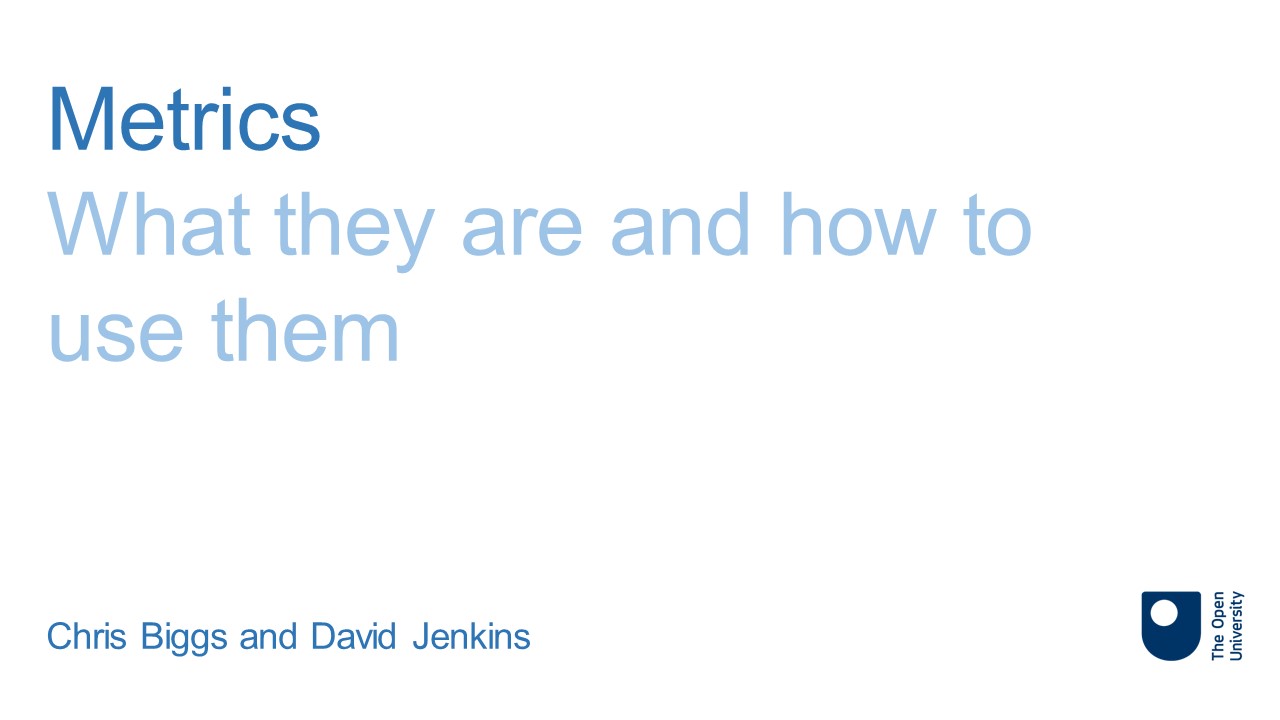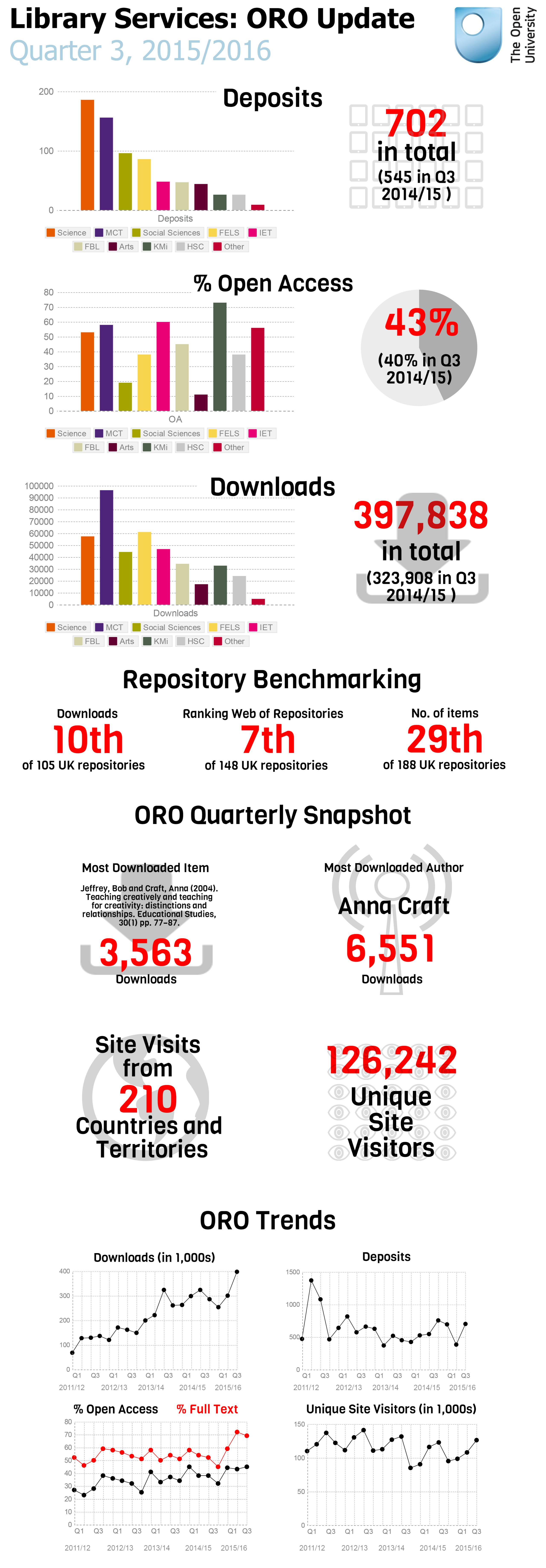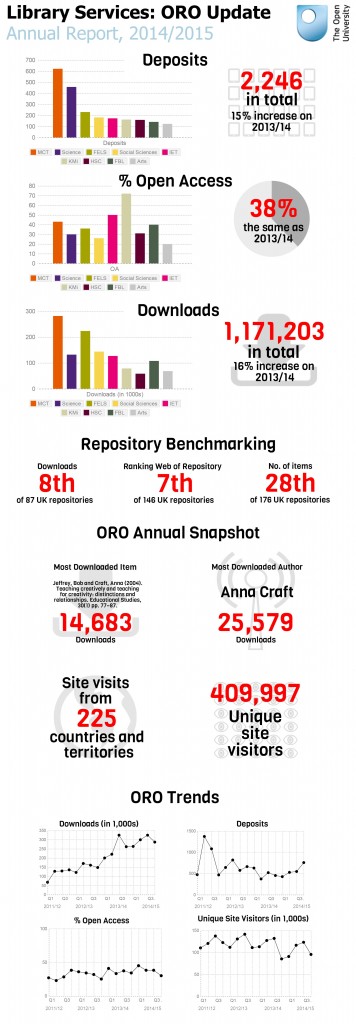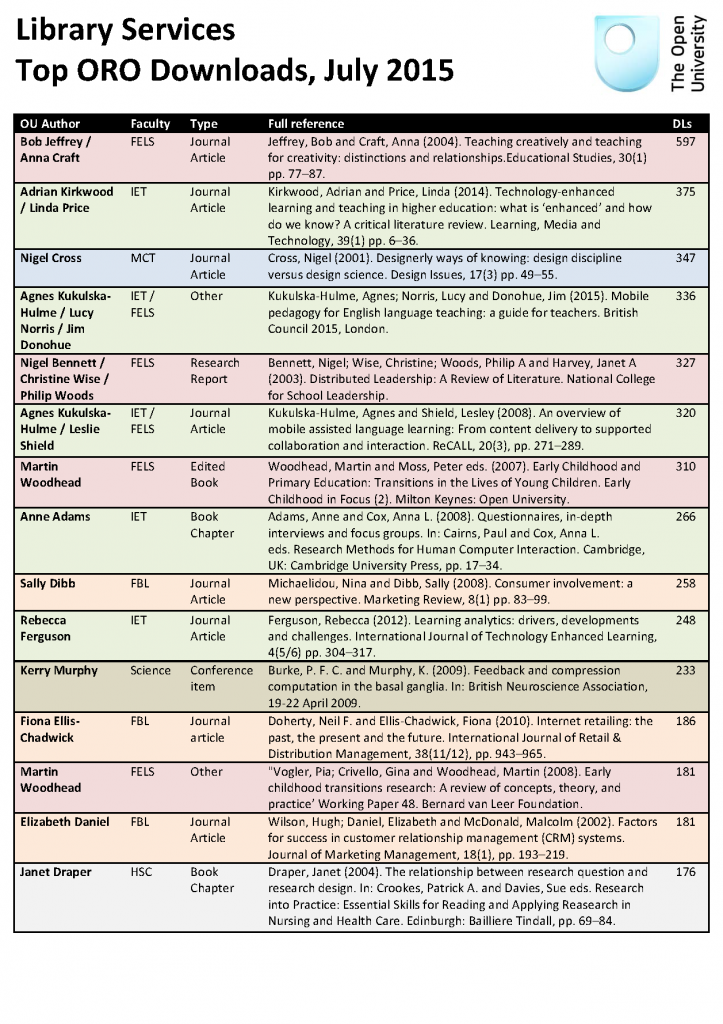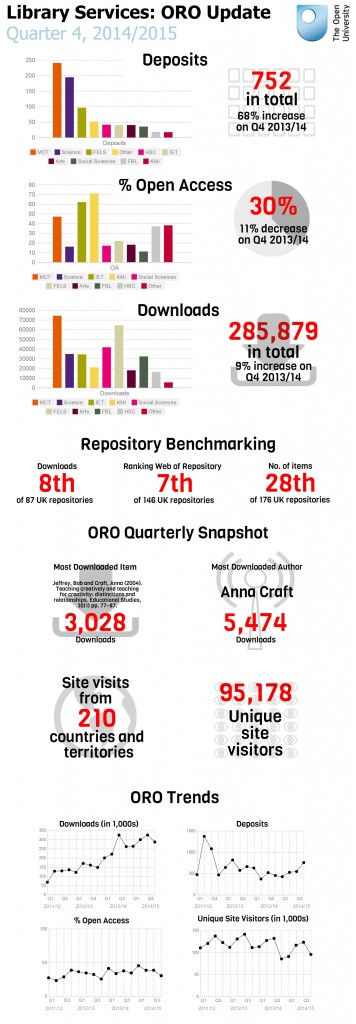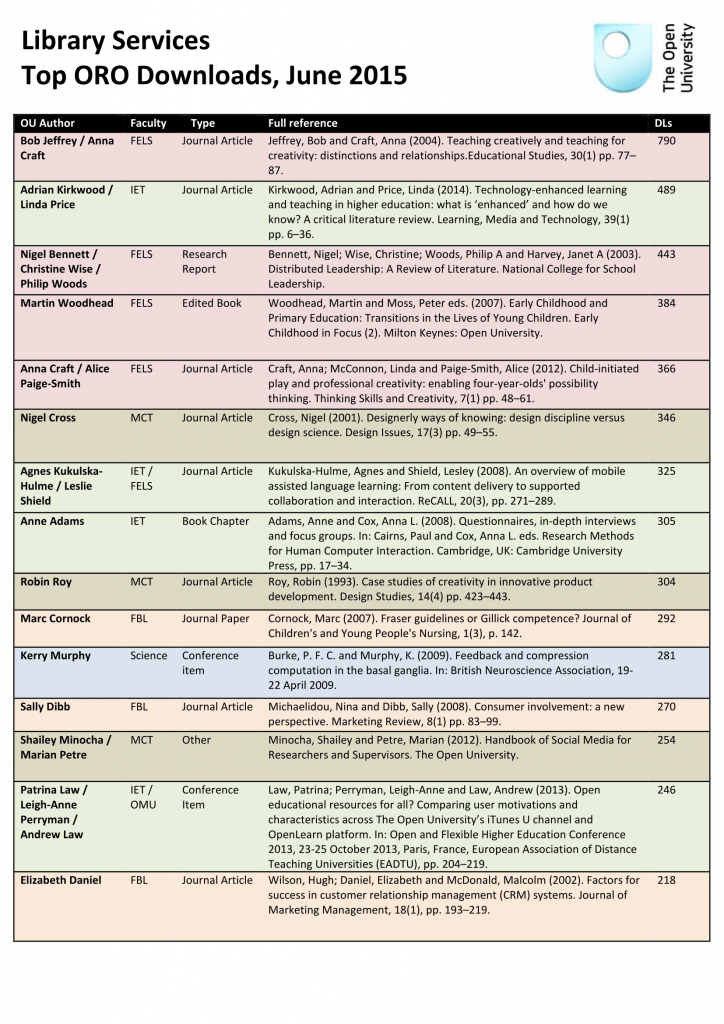Thanks to a handy post on DIY altmetrics I’ve put together a list of top OU publications as ranked by their Altmetric score. An Altmetric score is calculated by the number of mentions a paper receives in the social media and news outlets (e.g. blogs, Twitter, Facebook, Google+, message boards and mainstream newspapers). The basic claim of altmetrics is that it measures the reach of research in the wider world beyond academia.
I’ve posted the top 20 papers (co-)authored by an OU researcher below. A long list (Digital Object Identifiers, titles and ORO IDs only) is here: ORO Altmetrics Full List.
Fascinating reading, the top 20 is dominated by multi-authored Physical Science papers, frequently in high impact factor journal titles. And that’s got to be no great surprise given the strength of OU research in this field. But there are interesting exceptions both in the Top 20 and in the long list!
In order for a publication to appear it has to have a DOI and it has to be archived in ORO – that’s where i got the DOIs! The raw data is in this google sheet.
The Top 20 OU Publications as ranked by Altmetrics
Sager, William W.; Zhang, Jinchang; Korenaga, Jun; Sano, Takashi; Koppers, Anthony A. P.; Widdowson, Mike and Mahoney, John J. (2013). An immense shield volcano within the Shatsky Rise oceanic plateau, northwest Pacific Ocean. Nature Geoscience, 6 pp. 976–981.
McLennan, S. M.; Anderson, R. B.; Bell III, J. F.; Bridges, J. C.; Calef III, J. F.; Campbell, J. L.; Clark, B. C.; Clegg, S.; Conrad, P.; Cousin, A.; Des Marais, D. J.; Dromart, G.; Dyar, M. D.; Edgar, L. A.; Ehlmann, B. L.; Fabre, C.; Forni, O.; Gasnault, O.; Gellert, R.; Gordon, S.; Grant, J. A.; Grotzinger, J. P.; Gupta, S.; Herkenhoff, K. E.; Hurowitz, J. A.; King, P. L.; Le Mouélic, S.; Leshin, L. A.; Léveille, R.; Lewis, K. W.; Mangold, N.; Maurice, S.; Ming, D. W.; Morris, R. V.; Nachon, M.; Newsom, H. E.; Olilla, A. M.; Perrett, G. M.; Rice, M. S.; Schmidt, M. E.; Schwenzer, S. P.; Stack, K.; Stolper, E. M.; Sumner, D. Y.; Treiman, A. H.; VanBommel, S.; Vaniman, D. T.; Vasavada, A.; Wiens, R. C.; Yingst, R. A. and Science Team, MSL (2014). Elemental geochemistry of sedimentary rocks at Yellowknife Bay, Gale Crater, Mars. Science, 343(6169), article no. 1244734.
Braga-Ribas, F.; Sicardy, B.; Ortiz, J. L.; Snodgrass, C.; Roques, F.; Vieira-Martins, R.; Camargo, J. I. B.; Assafin, M.; Duffard, R.; Jehin, E.; Pollock, J.; Leiva, R.; Emilio, M.; Machado, D. I.; Colazo, C.; Lellouch, E.; Skottfelt, J.; Gillon, M.; Ligier, N.; Maquet, L.; Benedetti-Rossi, G.; Ramos Gomes, A.; Kervella, P.; Monteiro, H.; Sfair, R.; El Moutamid, M.; Tancredi, G.; Spagnotto, J.; Maury, A.; Morales, N.; Gil-Hutton, R.; Roland, S.; Ceretta, A.; Gu, S.-h.; Wang, X.-b.; Harpsøe, K.; Rabus, M.; Manfroid, J.; Opitom, C.; Vanzi, L.; Mehret, L.; Lorenzini, L.; Schneiter, E. M.; Melia, R.; Lecacheux, J.; Colas, F.; Vachier, F.; Widemann, T.; Almenares, L.; Sandness, R. G.; Char, F.; Perez, V.; Lemos, P.; Martinez, N.; Jørgensen, U. G.; Dominik, M.; Roig, F.; Reichart, D. E.; LaCluyze, A. P.; Haislip, J. B.; Ivarsen, K. M.; Moore, J. P.; Frank, N. R. and Lambas, D. G. (2014). A ring system detected around the Centaur (10199) Chariklo. Nature, 508(7494) pp. 72–75.
Sierks, Holger; Barbieri, Cesare; Lamy, Philippe L.; Rodrigo, Rafael; Koschny, Detlef; Rickman, Hans; Keller, Horst Uwe; Agarwal, Jessica; A’Hearn, Michael F.; Angrilli, Francesco; Auger, Anne-Therese; Barucci, M. Antonella; Bertaux, Jean-Loup; Bertini, Ivano; Besse, Sebastien; Bodewits, Dennis; Capanna, Claire; Cremonese, Gabriele; Da Deppo, Vania; Davidsson, Björn; Debei, Stefano; De Cecco, Mariolino; Ferri, Francesca; Fornasier, Sonia; Fulle, Marco; Gaskell, Robert; Giacomini, Lorenza; Groussin, Olivier; Gutierrez-Marques, Pablo; Gutiérrez, Pedro J.; Güttler, Carsten; Hoekzema, Nick; Hviid, Stubbe F.; Ip, Wing-Huen; Jorda, Laurent; Knollenberg, Jörg; Kovacs, Gabor; Kramm, J. Rainer; Kührt, Ekkehard ; Küppers, Michael; La Forgia, Fiorangela; Lara, Luisa M.; Lazzarin, Monica; Leyrat, Cédric; Lopez Moreno, Josè J.; Magrin, Sara; Marchi, Simone; Marzari, Francesco; Massironi, Matteo; Michalik, Harald; Moissl, Richard; Mottola, Stefano; Naletto, Giampiero; Oklay, Nilda; Pajola, Maurizio; Pertile, Marco; Preusker, Frank; Sabau, Lola; Scholten, Frank; Snodgrass, Colin; Thomas, Nicholas; Tubiana, Cecilia; Vincent, Jean-Baptiste; Wenzel, Klaus-Peter; Zaccariotto, Mirco and Pätzold, Martin (2015). On the nucleus structure and activity of comet 67P/Churyumov-Gerasimenko. Science, 347(6220), article no. aaa1044.
Williams, R. M. E.; Grotzinger, J. P.; Dietrich, W. E. ; Gupta, S.; Sumner, D. Y; Wiens, R. C.; Mangold, N.; Malin , M. C.; Edgett, K. S.; Maurice, S.; Forni, O.; Gasnault, O.; Ollila, A.; Newsom, H. E.; Dromart, G.; Palucis, M. C.; Yingst, R. A.; Anderson, R. B.; Herkenhoff, K. E.; Le Mouelic, S. ; Goetz, W.; Madsen, M. B.; Koefoed, A.; Jensen, J. K.; Bridges, J. C.; Schwenzer, S. P.; Lewis , K. W.; Stack, K. M.; Rubin, D.; Kah, L. C.; Bell III, J. F.; Farmer, J. D.; Sullivan, R.; Van Beek, T.; Blaney, D. L.; Pariser, O. and Deen, R. G. (2013). Martian Fluvial Conglomerates at Gale Crater. Science, 340(6136) pp. 1068–1072.
Farley, K. A.; Malespin, C.; Mahaffy, P.; Grotzinger, J. P.; Vasconcelos, P. M.; Milliken, R. E.; Malin, M.; Edgett, K. S.; Pavlov, A. A.; Hurowitz, J. A.; Grant, J. A.; Miller, H. B.; Arvidson, R.; Beegle, L.; Calef, F.; Conrad, P.; Dietrich, W. E.; Eigenbrode, J.; Gellert, R.; Gupta, S.; Hamilton, V.; Hassler, D. M.; Lewis, K. W.; McLennan, S. M.; Ming, D.; Navarro-González, R.; Schwenzer, S. P.; Steele, A.; Stolper, D. M.; Sumner, D. Y.; Vaniman, D.; Vasavada, A.; Williford, K.; Wimmer-Schweingruber, R. F. and Science Team, MSL (2014). In situ radiometric and exposure age dating of the Martian surface. Science, 343(6169), article no. 1247166.
Johnson, Diane; Tyldesley, Joyce; Lowe, Tristan; Withers, Philip. J. and Grady, Monica M. (2013). Analysis of a prehistoric Egyptian iron bead with implications for the use and perception of meteorite iron in ancient Egypt. Meteoritics & Planetary Science, 48(6) pp. 997–1006.
Rotundi, Alessandra; Sierks, Holger; Della Corte, Vincenzo; Fulle, Marco; Gutierrez, Pedro J.; Lara, Luisa; Barbieri, Cesare; Lamy, Philippe L.; Rodrigo, Rafael; Koschny, Detlef; Rickman, Hans; Keller, Horst Uwe; López-Moreno, José J.; Accolla, Mario; Agarwal, Jessica; A’Hearn, Michael F.; Altobelli, Nicolas; Angrilli, Francesco; Barucci, M. Antonietta; Bertaux, Jean-Loup; Bertini, Ivano; Bodewits, Dennis; Bussoletti, Ezio; Colangeli, Luigi; Cosi, Massimo; Cremonese, Gabriele; Crifo, Jean-Francois; Da Deppo, Vania; Davidsson, Björn; Debei, Stefano; De Cecco, Mariolino; Esposito, Francesca; Ferrari, Marco; Fornasier, Sonia; Giovane, Frank; Gustafson, Bo; Green, Simon F.; Groussin, Olivier; Grün, Eberhard; Güttler, Carsten; Herranz, Miguel L.; Hviid, Stubbe F.; Ip, Wing; Ivanovski, Stavro; Jerónimo, José M.; Jorda, Laurent ; Knollenberg, Joerg; Kramm, Rainer; Kührt, Ekkehard; Küppers, Michael; Lazzarin, Monica; Leese, Mark R.; López-Jiménez, Antonio C.; Lucarelli, Francesca; Lowry, Stephen C.; Marzari, Francesco; Epifani, Elena Mazzotta; McDonnell, J. Anthony M.; Mennella, Vito; Michalik, Harald; Molina, Antonio; Morales, Rafael; Moreno, Fernando; Mottola, Stefano; Naletto, Giampiero; Oklay, Nilda; Ortiz, José L.; Palomba, Ernesto; Palumbo, Pasquale; Perrin, Jean-Marie; Rodríguez, Julio; Sabau, Lola; Snodgrass, Colin; Sordini, Roberto; Thomas, Nicolas; Tubiana, Cecilia; Vincent, Jean-Baptiste; Weissman, Paul; Wenzel, Klaus-Peter; Zakharov, Vladimir and Zarnecki, John C. (2015). Dust measurements in the coma of comet 67P/Churyumov-Gerasimenko inbound to the Sun. Science, 347(6220), article no. 905.
Thomas, Nicolas; Sierks, Holger; Barbieri, Cesare; Lamy, Philippe L.; Rodrigo, Rafael; Rickman, Hans; Koschny, Detlef; Keller, Horst Uwe; Agarwal, Jessica; A’Hearn, Michael F.; Angrilli, Francesco; Auger, Anne-Therese; Barucci, M. Antonella; Bertaux, Jean-Loup; Bertini, Ivano; Besse, Sebastien; Bodewits, Dennis; Cremonese, Gabriele; Da Deppo, Vania; Davidsson, Björn; De Cecco, Mariolino; Debei, Stefano; El-Maarry, Mohamed Ramy; Ferri, Francesca; Fornasier, Sonia; Fulle, Marco; Giacomini, Lorenza; Groussin, Olivier; Gutierrez, Pedro J.; Güttler, Carsten; Hviid, Stubbe F.; Ip, Wing-Huen; Jorda, Laurent; Knollenberg, Jörg; Kramm, J.-Rainer; Kührt, Ekkehard; Küppers, Michael; La Forgia, Fiorangela; Lara, Luisa M.; Lazzarin, Monica; Moreno, Josè J. L.; Magrin, Sara; Marchi, Simone; Marzari, Francesco; Massironi, Matteo; Michalik, Harald; Moissl, Richard; Mottola, Stefano; Naletto, Giampiero; Oklay, Nilda; Pajola, Maurizio; Pommerol, Antoine; Preusker, Frank; Sabau, Lola; Scholten, Frank; Snodgrass, Colin; Tubiana, Cecilia; Vincent, Jean-Baptiste and Wenzel, Klaus-Peter (2015). The morphological diversity of comet 67P/Churyumov-Gerasimenko. Science, 347(6220), article no. aaa0440.
Schulte, Peter; Alegret, Laia; Arenillas, Ignacio; Arz, José A.; Barton, Penny J.; Bown, Paul R.; Bralower, Timothy J.; Christeson, Gail L.; Claeys, Philippe; Cockell, Charles S.; Collins, Gareth S.; Deutsch, Alexander; Goldin, Tamara J.; Goto, Kazuhisa; Grajales-Nishimura, José M.; Grieve, Richard A. F.; Gulick, Sean P. S.; Johnson, Kirk R.; Kiessling, Wolfgang; Koeberl, Christian; Kring, David A.; MacLeod, Kenneth G.; Matsui, Takafumi; Melosh, Jay; Montanari, Alessandro; Morgan, Joanna V.; Neal, Clive R.; Nichols, Douglas J.; Norris, Richard D.; Pierazzo, Elisabetta; Ravizza, Greg; Rebolledo-Vieyra, Mario; Reimold, Wolf Uwe; Robin, Eric; Salge, Tobias; Speijer, Robert P.; Sweet, Arthur R.; Urrutia-Fucugauchi, Jaime; Vajda, Vivi; Whalen, Michael T. and Willumsen, Pi S. (2010). The Chicxulub asteroid impact and mass extinction at the Cretaceous-Paleogene boundary. Science, 327(5970) pp. 1214–1218.
Hastings, Gerard (2012). Why corporate power is a public health priority. British Medical Journal, 345 e5124.
Aoudjehane , H. Chennaoui; Avice, G.; Barrat, J.-A.; Boudouma, O.; Chen, G.; Duke, M.J.M; Franchi, I. A.; Gattacceca, J.; Grady, M. M.; Greenwood, R. C.; Herd, C. D. K.; Hewins, R.; Jambon, A.; Marty, B.; Rochette, P.; Smith, C. L.; Sautter, V.; Verchovsky, A.; Weber , P. and Zanda, B. (2012). Tissint martian meteorite: a fresh look at the interior, surface, and atmosphere of Mars. Science, 338(6108) pp. 785–788.
Sutherland, William J.; Bellingan, Laura; Bellingham, Jim R.; Blackstock, Jason J.; Bloomfield, Robert M.; Bravo, Michael; Cadman , Victoria M.; Cleevely, David D.; Clements, Andy; Cohen, Anthony; Cope, David R.; Daemmrich, Arthur A.; Devecchi, Cristina; Diaz Anadaon, Laura; Denegri, Simon; Doubleday, Robert; Dusic, Nicholas R.; Evans, Robert J.; Feng, Wai Y.; Godfray, H. Charles J.; Harris, Paul; Hartley, Sue E.; Hester, Alison J.; Holmes, John; Hughes, Alan; Hulme, Mike; Irwin, Colin; Jennings, Richard C.; Kass, Gary S.; Littlejohns, Peter; Marteau, Theresa M.; McKee, Glenn; Millstone, Erik P.; Nuttall, William J.; Owens, Susan; Parker, Miles M.; Pearson, Sarah; Petts, Judith; Ploszek, Richard; Pullin, Andrew S.; Reid, Graeme; Richards, Keith S.; Robinson, John G.; Shaxson, Louise; Sierra, Leonor; Smith, Beck G.; Spiegelhalter, David J.; Stilgoe, Jack; Stirling, Andy; Tyler, Christopher P.; Winickoff, David E. and Zimmern, Ron L. (2012). A collaboratively-derived science-policy research agenda. PLoS ONE, 7(3)
Kandasamy, Narayanan; Hardy, Ben; Page, Lionel; Schaffner, Markus; Graggaber, Johann; Powlson, Andrew S.; Fletcher, Paul C.; Gurnell, Mark and Coates, John (2014). Cortisol shifts financial risk preferences. Proceedings of the National Academy of Sciences, 111(9) pp. 3608–3613.
Jenniskens, Peter; Fries, Mark D.; Qing-Zhu , Yin; Zoleensky, Michael; Krot , Alexander N.; Sanford, Scott A.; Sears, Derek; Bauford, Robert; Ebel, Denton S.; Friedrich, Jon M.; Nagashima, Kazuhide; Wimpenny, Josh; Yamakawa, Akane; Nishiizumi, Kunihiko; Hamajima , Yasunori; Caffee, Marc; Weten, Kees C.; Laubenstein, Matthias; Davis, Andrew; Simon, Stiven B.; Heck, Philipp R.; Young , Edward D.; Kohl , Issaku E.; Thimens , Mark H.; Nunn, Morgan H.; Mikouchi, Takashi; Hagiya, Kenji; Ohsumi, Kazumasa; Cahill, Thomas A.; Lawton, Jonathan A.; Barnes , David; Steele, Andrew; Rochette, Pierre; Verosub, Kenneth L.; Gattacceca, Jerome; Cooper , George; Glavin, Daniel P.; Burton, Aaron S.; Dworkin, Jason P.; Elsila, Jamie E. ; Pizzerello, Sandra; Ogliore, Ryan; Schitt-Kopplin, Phillipe; Harir, Mourad; Hertkorn, Norbert; Verchovsky, Sasha; Grady, Monica; Nagao, Keisuke; Okazaki, Ryuji; Takechi, Hiroyuki; Hirori, Takahiro; Smith, Ken; Silber, Elizabeth A.; Brown, Peter G; Albers, Jim; Klotz , Doug; Hankey, Mike; Matson, Robert; Fries, Jeffrey A.; Walker , Richard J.; Puchtel, Igor; Lee, Cin-Ty A.; Erdman, Monica E.; Eppich, Gary R.; Roeske, Sarah; Gabelica, Zelimir; Lerche, Michael; Nuevo, Michel; Girten, Beverly and Worden, Simon P. (2012). Radar-enabled recovery of the Sutter’s Mill meteorite, a carbonaceous chondrite regolith breccia. Science, 338(6114) pp. 1583–1587.
Zhang, Fucheng; Kearns, Stuart L.; Orr, Patrick J.; Benton, Michael J.; Zhou, Zhonghe; Johnson, Diane; Xu, Xing and Wang, Xiaolin (2010). Fossilized melanosomes and the colour of Cretaceous dinosaurs and birds. Nature, 463(7284) p. 1075.
Roelfsema, Martine T.; Hoekstra, Rosa A.; Allison, Carrie; Wheelwright, Sally; Brayne, Carol; Matthews, Fiona E. and Baron-Cohen, Simon (2012). Are autism spectrum conditions more prevalent in an information-technology region? A school-based study of three regions in the Netherlands. Journal of Autism and Developmental Disorders, 42(5) pp. 734–739.
Sierks, H.; Lamy, P.; Barbieri, C.; Koschny, D.; Rickman, H.; Rodrigo, R.; A’Hearn, M. F.; Angrilli, F.; Barucci, M. A.; Bertaux, J.- L.; Bertini, I.; Besse, S.; Carry, B.; Cremonese, G.; Da Deppo, V.; Davidsson, B.; Debei, S.; De Cecco, M.; De Leon, J.; Ferri, F.; Fornasier, S.; Fulle, M.; Hviid, S. F.; Gaskell, R. W.; Groussin, O.; Gutierrez, P.; Ip, W.; Jorda, L.; Kaasalainen, M.; Keller, H. U.; Knollenberg, J.; Kramm, R.; Kuhrt, E.; Kuppers, M.; Lara, L.; Lazzarin, M.; Leyrat, C.; Moreno, J. J. L.; Magrin, S.; Marchi, S.; Marzari, F.; Massironi, M.; Michalik, H.; Moissl, R.; Naletto, G.; Preusker, F.; Sabau, L.; Sabolo, W.; Scholten, F.; Snodgrass, C.; Thomas, N.; Tubiana, C.; Vernazza, P.; Vincent, J.- B.; Wenzel, K.- P.; Andert, T.; Patzold, M. and Weiss, B. P. (2011). Images of asteroid 21 Lutetia: a remnant planetesimal from the early solar system. Science, 334(6055) pp. 487–490.
Rose, Gillian (2014). On the relation between ‘visual research methods’ and contemporary visual culture. Sociological Review, 62(1) pp. 24–46.
Spiegelhalter, David; Pearson, Mike and Short, Ian (2011). Visualizing uncertainty about the future. Science, 333(6048) pp. 1393–1400.

